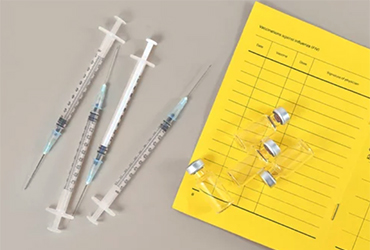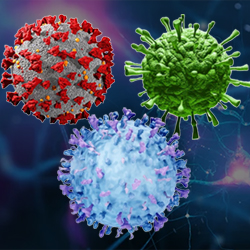By Marie Rosenthal, MS
Both of the bivalent COVID-19 boosters appear effective against existing and emerging strains of SARS-CoV-2, according to data released by both vaccine makers.

The CDC said deaths from COVID-19 have decreased substantially likely due to high levels of immunity in the general population, through either vaccination and/or past infection. Between 2,000 and 4,500 people are still dying every week, however. Mortality continues to be higher among very elderly people, those with underlying conditions or disabilities, and individuals who are not up-to-date with their COVID-19 vaccination.
In the United States, only 11.5% of people older than 5 years of age, who are indicated for the bivalent booster doses, have received one.
Data From Moderna
In a phase 2/3 study, a booster dose of mRNA-1273.222 of 50 mcg elicited a superior neutralizing antibody response against omicron BA.4/BA.5 variants when compared with a 50-mcg booster dose of mRNA-1273 in 511 previously vaccinated and boosted participants (age, 19-89 years). It also demonstrated activity against BQ1.1, the newest subvariant, although it was lower than against the BA.4/BA.5 variants. BQ.1 and BQ.1.1 are the cause of almost 50% of cases right now, according to the CDC.
Participants received mRNA-1273.222 and mRNA-1273 approximately 9.5 and 4.5 months after their prior vaccination, respectively. Pre-booster BA.4/BA.5 titers were similar in the mRNA-1273.222 and mRNA-1273 groups. The omicron BA.4/BA.5 geometric mean titer (GMT) ratios of mRNA-1273.222 versus mRNA-1273 were 5.11 (95% CI, 4.10-6.36) and 6.29 (95% CI, 5.27-7.51) for participants with and without SARS-CoV-2 infection pre-booster, respectively. In all participants, the GMT against omicron BA.4/BA.5 was 4,289 (95% CI, 3,789.0-4,855.9), representing a 15.1-fold increase (95% CI, 13.3-17.1) from pre-booster levels. For participants without past infection, the GMT was 2,325 (95% CI, 1,321.2-2,812.7), representing a 26.4-fold increase (95% CI, 22.0-31.9). For those with past infection, the GMT was 6,965 (95% CI, 6,043.7-8,025.4), representing a 9.8-fold (95% CI, 8.4-11.4), increase from pre-booster levels. Importantly, results were consistent between participants ages 65 years and older and those ages 18 to 65.
In an exploratory analysis of approximately 40 participants using research assays, both bivalent vaccines demonstrated robust neutralizing activity against BQ.1.1, despite an approximately fivefold drop in titers compared with BA.4/BA.5.
A booster dose of mRNA-1273.214 of 50 mcg elicited a superior neutralizing antibody response against omicron BA.1 and BA.4/BA.5 compared with the booster dose of mRNA-1273, with superiority lasting at least three months. In both groups, participants received the booster dose approximately 4.5 months after prior vaccination (N Engl J Med 2022;387:1279-1291).
The frequency of adverse reactions to mRNA-1273.222 and mRNA-1273.214 was similar to or lower than that of either a second or third dose of the original vaccine. Additionally, no new safety concerns were identified after approximately one month and three months of follow-up, respectively.
Data From Pfizer-BioNTech
One month after a 30-mcg booster dose of the omicron BA.4/BA.5?adapted bivalent COVID-19 vaccine, neutralizing antibody titers against emerging omicron sublineages increased 3.2- to 4.8-fold compared with the companies’ original COVID-19 vaccine.
Neutralizing antibody titers against omicron sublineages BA.4.6, BA.2.75.2, BQ.1.1 and XBB.1 increased 4.8- to 11.1-fold from pre-booster levels, following a booster with the bivalent vaccine.
These data indicate that the companies’ bivalent vaccine elicits a greater increase in neutralizing antibody titers than the companies’ original COVID-19 vaccine against these emerging omicron sublineages. Based on these findings, the omicron BA.4/BA.5?adapted bivalent booster may help to provide improved protection against COVID-19 due to omicron BA.4 and BA.5 sublineages, as well as new sublineages that continue to increase in prevalence (bioRxiv 2022 Nov 17. doi: https://doi.org/10.1101/2022.11.17.516898).
Neutralization data were generated using a non-validated fluorescent focus reduction neutralization test (FFRNT) one month after administration of a fourth dose of the companies’ omicron BA.4/BA.5?adapted bivalent COVID-19 vaccine or the original COVID-19 vaccine in adults ages 55 and older (approximately 40 per vaccine group). Sera were equally stratified by past SARS-CoV-2 infection. Results showed the bivalent vaccine booster elicited a greater rise in neutralizing antibody titers for all tested omicron sublineages compared with the original vaccine, regardless of past SARS-CoV-2 infection status.
After a booster dose of the omicron BA.4/BA.5?adapted bivalent COVID-19 vaccine, neutralizing antibodies against BA.4.6 increased 11.1-fold (95% CI, 7.1-17.3), while neutralizing antibodies against BA.2.75.2, BQ.1.1 and XBB.1 increased by 6.7-fold (95% CI, 4.4-10.2), 8.7-fold (95% CI, 5.7-13.3) and 4.8-fold (95% CI, 3.3-6.9), respectively. By comparison, the neutralizing antibody titers against BA.4.6, BA.2.75.2, BQ.1.1 and XBB.1 following a booster dose of the companies’ original COVID-19 vaccine increased 2.3-fold (95% CI, 1.9-2.8), 2.1-fold (95% CI, 1.7-2.5), 1.8-fold (95% CI, 1.6-2.2) and 1.5-fold (95% CI, 1.3-1.8), respectively. Overall, the bivalent booster generated a greater increase in neutralizing antibodies against emerging omicron sublineages than the original Pfizer-BioNTech COVID-19 vaccine.
These results are similar to recent clinical data showing the omicron BA.4/BA.5?adapted bivalent booster causes a 13-fold increase in BA.4/BA.5-neutralizing titers from pre-booster levels in individuals 55 years and older, resulting in a fourfold higher BA.4/BA.5 response than the companies’ original COVID-19 vaccine.
A booster dose of the omicron BA.4/BA.5?adapted bivalent COVID-19 vaccine has been authorized for emergency use by the FDA for people ages 5 years and older with the Pfizer-BioNTech vaccine and 6 and older with the Moderna vaccine.




